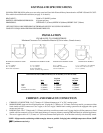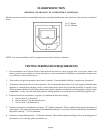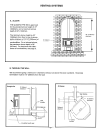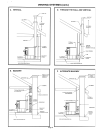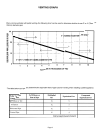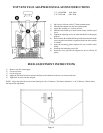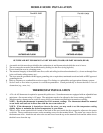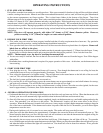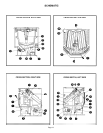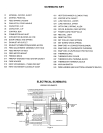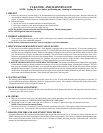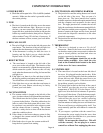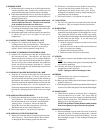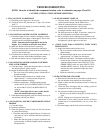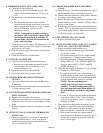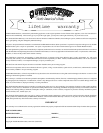
9. THERMOCOUPLE
A. The thermocouple is located on top of the firepot inside the
ceramic protection tube. Remove the ceramic tube and
inspect the thermocouple for deterioration or breakage.
B. Check the terminal block screws to see if they are tight and
making a good electrical connection (located on the top of
the lower junction box).
NOTE: The yellow wire is connected to the terminal located
closest to the front of the stove. The red wire is connected
to the terminal closest to the rear of the stove.
C. Upon reinstalling the ceramic cover, be sure the thermocouple
is touching the inside end of the ceramic tube and that the
cover is extending 1” (25mm) into the firepot.
D. The thermocouple sends a millivolt signal to the control box
to obtain the green and red lights for the preset
temperatures.
10. SNAP DISC #1 (CONVECTION BLOWER) - 125°F
A. Snap disc #1 is located on the bottom of the heat
exchanger next to the convection blower. This snap disc
turns the convection blower (heated air) on and off as
needed. Power is always present at snap disc #1.
11. SNAP DISC #2 (THERMOSTAT OVERRIDE) -250
°°
°°
°F
A. Snap disc #2 is located next to snap disc #1, farthest from
the convection blower. This snap disc will bypass the
thermostat and turn off the stove if an overheat condition
occurs, or if the convection blower should fail to operate.
The stove will go into a normal shutdown: the combustion
blower will run for ten minutes, then turn off . After the
stove cools, the snap disc will automatically reset itself and
the stove will relight.
12. SNAP DISC #3 (BACKBURN PROTECTOR) - 200
°°
°°
°F
A. Snap disc #3 is located on the right side of the feed tube
(accessed through stove top). If, for any reason, the fire
tries to burn back into the feed system or push exhaust up
the feed tube, this snap disc will shut the entire system off.
However, sometimes in shipment the disc will trip and shut
power off to the entire stove. To reset, unplug the stove
from outlet and push in the red reset button in the center of
the snap disc, then plug the stove back in and try to relight
it.
13. BLOWER #1 (EXHAUST BLOWER)
A. The 80 cfm exhaust blower is located on the lower right
side of the stove. The exhaust blower is designed to pull
the exhaust from the stove and push it out through the
venting system. To inspect it, remove the right rear
(facing the stove from the front) pedestal access door.
The blower may now be visually inspected.
B. This blower requires a 3 uf capacitor for operation.
14. BLOWER #2 (CONVECTION BLOWER)
A. The 80 cfm convection blower is located on the lower left
side of the stove. The convection blower blows heated
air through the heat exchange system into the room.
B. The blower is accessible by removing the left rear (facing
the stove from the front) pedestal access door. You
should inspect this blower at least once a year. If dust
buildup has accumulated, clean by simply brushing and
vacuuming dust off the blades.
C. This blower requires a 4 uf capacitor for operation.
15. CAPACITORS
A. The 3 and 4 uf capacitors are located in the lower left side
of the stove. They are seated in the lower junction box.
16. FEED SYSTEM
A. The feed system is located beneath the top of the stove and
centered in front of the hopper. Lift the hopper lid to access.
This system pulls pellets, by using a hollow auger spring,
up the feed tube from the hopper area and drops them down
the feed chute into the firepot. If you are having fuel
problems check the following:
1. Check the ramp in the firepot to see that it is free of fuel
or other materials.
2. Check the set screw on the end of the motor shaft to see
that it is tight and not slipping.
3. Check the electrical power to motor.
4. Check the vacuum switch hose connections.
17. IGNITER
A. The igniter is located in the chamber at the bottom of the
firepot.
NOTE: The element on the igniter is extremely brittle. Be
very careful in handling it.
B. Check the wire leads to the igniter for loose or bad
connections (ceramic wire nuts).
NOTE: Unplug stove before checking wire nuts.
18. FIREPOT
A. Clean the firepot (see section on cleaning and
maintenance on page 15).
B. Make sure the cleanout plate in the bottom of the firepot is
pushed in all the way.
C. Check the gasket between the firepot and the firebox bottom.
A bad seal will affect the ignition time and the flame height.
19. DOOR GASKET
A. Check the door gasket to see that the door is completely
closed and there are no air leaks. This can be done by
closing the door on a piece of paper and checking that the
paper is firmly held in place. You should have resistance
when you try to pull the paper away.
NOTE: If no resistance is found, the door handle assembly
needs to be adjusted or rope seal needs to be replaced.
20. HEAT EXCHANGERS
A. The heat exchangers (one on each side) can be accessed by
lifting the stove top. Each heat exchanger has a cleanout
rod located in the center of the heat exchanger. To clean
heat exchanger see page 15, heat exchanger cleaning and
maintenance.
Page 17



